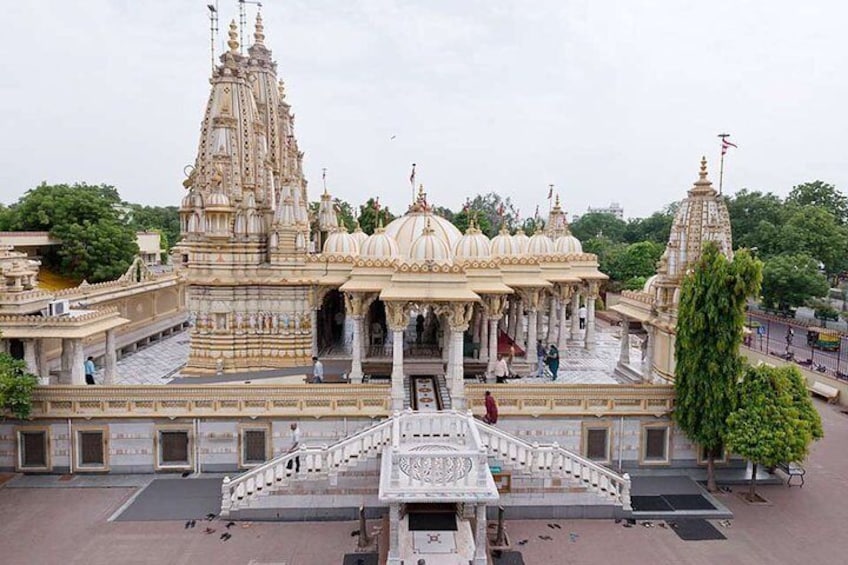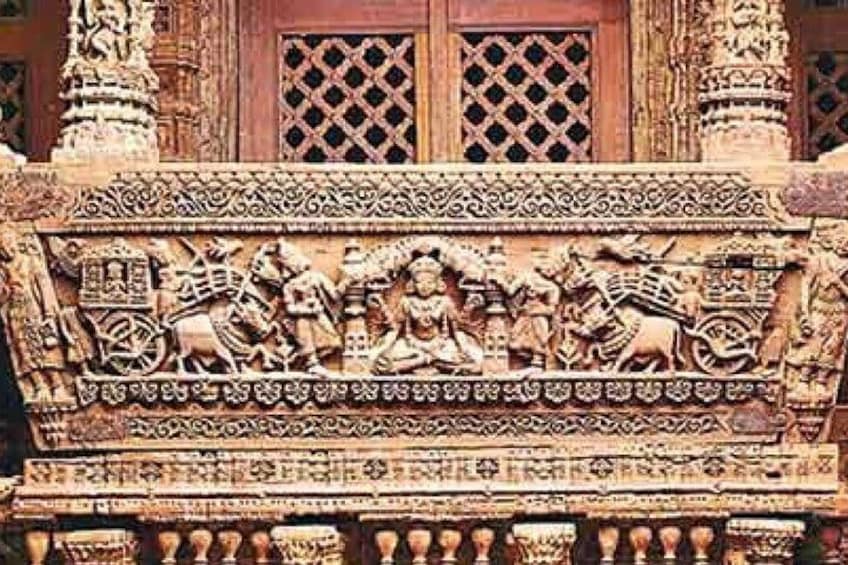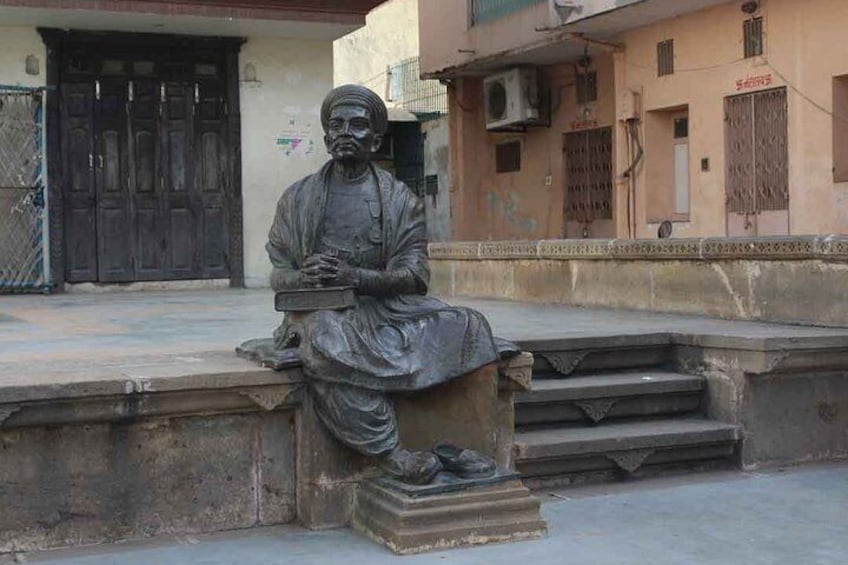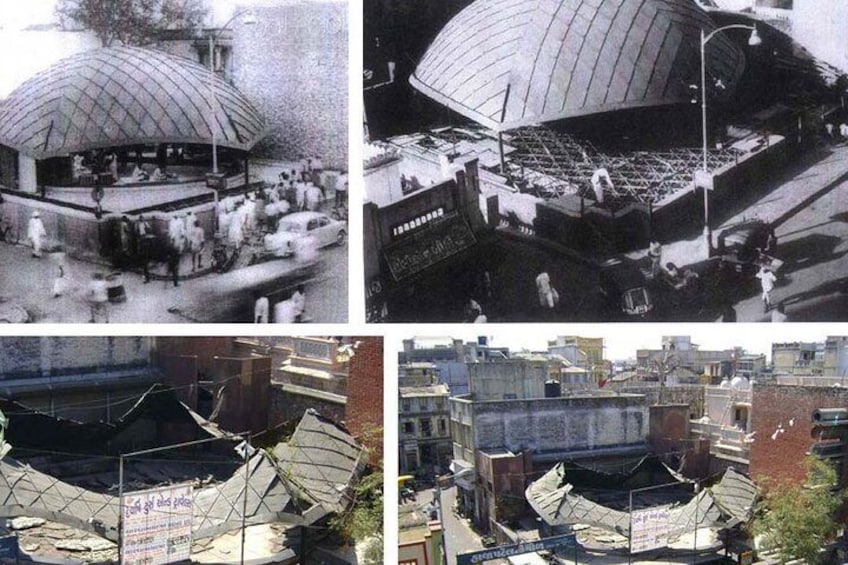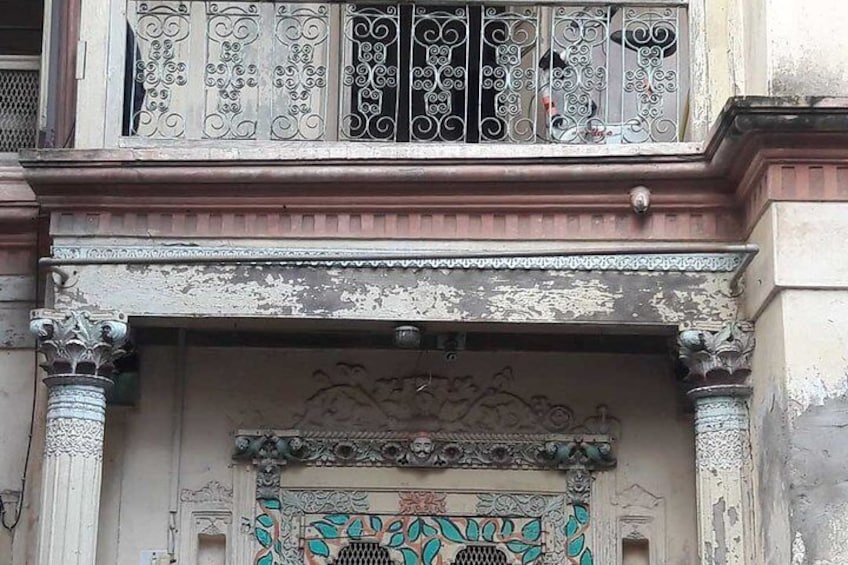Ahmedabad
Shantinathji Mandir, Haja Patel ni Pol
A Panorama of this Pol reveals an idyllic and laid back picture of life in the pols. One often gets to see cows ambling and ruminating lazily, old men are chatting, a handful of women performing their daily stints on the “Otla”. A beautifully carved wooden Chabutara stands in the midst of silence, behind is the magnificent Shantinath nu Derasar. However, the awesome splendour of the Derasar is only visible when one enters it. Shantinath Derasar is truly a feast to the eyes as one discovers the magnificence of the delicate wood carving in the carving in the ceiling of the dome, panels, brackets, jali, windows etc. was built by Shah Vakhatchand Malichand in the year 1923 A.D. There is a 19 inch his idol of Shantinath Tirthankar. It is believed that initially the entire temple was built of wood .When Relief Road was being constructed, the temple had to be shifted to the interior and it was reconstructed out of marble and some wooden component from the previous temple.
Kuvavala Khancho
Kuvavala Khancho is an crossroads that had adjacent wells near Shantinathji ni Pol, giving it its name (kuva is well and khancha, passage). Interesting thing to see In Kuvavala Khancha is 4 homes opposite to each other with elements of Persian, Mughal, Maratha and European architecture reflecting the respective periods in which each facade was built, and the emblems of the earlier owners above the doors. This shows the cosmopolitan culture of old Ahmedabad. Also, you can see the Chowk (square) with the Parrot Holes on walls of the houses. Such holes were made available in exterior walls of each houses of Pol to allow Parrots (or any birds) to prepare their nests in absence of trees.
Jagvallabh Mandir, Nisha Pol
Nisha pole is famous in Ahmedabad both for its old Jagvallabh Jain Temple & large size and delicate Hindu architecture. In Jagvallabh Parshvanath Derasar right from the entrance, devotee can have a glimpse of Parshvanath’s sahastrafena idol in Kayotsaraga posture. The second garbh-gruha of the Derasar built in the year 1603 by Nagarsheth Khushalchand enshrines small black idol of Shri Chintamani Parshvanath in Padmasan. The idols testify the heights Jains achieved in the fields of art and craftsmanship. The Derasar also has a six feet tall idol of Jain Tirthankar Lord Adinath sitting in Padmasana’s yogic posture.
Zaveri vad
This area is mostly inhabited by Goldsmith community. There are many haveli type houses with profusely decorated faced in the Pol.
Sambhavnath ni Khadki
Built in 1662 A.D. Sambhavnathji Derasar is believed to be the oldest Jain temple in Ahmedabad. According to the inscription on the temple wall, the original temple was constructed in wood. The building was later restored in 1904 A.D. using marble stone. This Derasar is built underground, only the dome and shikhara can be seen while one enters the Sambhavnath Ni Khadki.
Chaumukhji ni Khadki
Chaumukhji Ni Khadki was earlier called Satharni Khadki. The name is derived from Jain Derasar of Chaumukhji. Near to the Khadki is a Vaishnav sect Haveli of Gunsaiji. Historians’ believe that the remains of a Derasar from 10th century have been preserved in Ajitnathji Derasar in this area. This Khadki also has lot of Jain temple built in the Hindu-Jain architectural style.
Doshivada ni Pol
This area is mostly inhabited by goldsmith community Main road is lined with lots of small & medium jewellery shops. There are many haveli type houses with profusely decorated facades in the pol. towards the end of the Pol is a beautiful carved Chabutara with stained glasses. This is a unique example of colonial-influence on architecture of Chabutaras. There is also landmark building once considered tallest in the walled city.
Astapadji Mandir
At the end of Doshiwada ni pol, beside the Jain library is situated the marble Derasar of Ashtapadji. It is built in the Hindu–Jain style of architecture with elaborate decoration. The sculptures and motifs include human figure in dancing position or playing musical instruments, animals and various other floral patterns can be seen here. It was built around 1856 A.D. by Sheth Maganlal Karamchand. The Derasar has idols of Adishwar Bhagvan and Mahavir Swami. It also has the idols of Sheth and Shethani and their guru Apart from a host of other status. It is believed that 32 statuses are made of Ratikar Parvat’s red marble. 16 statues are made up of Dadhimukh Parvat’s red marble. 4 statues are made out of Nandishwar Island’s Anjangiri Parvat’s black marble. Just beside the Derasar. There is a Jain shop that sells the 5 required articles that a Jain Svetambar Monk carries.
Harkunvar Shethani ni haveli
The 180 year old Harkunvar Shethani ni Haveli contains 60 rooms, most of which open on to interminable pillared balconies, supported by the longest carved wooden bracket in Ahmedabad. Stunning wood carvings found on Harkunvar Shethani ni Haveli in Old City Ahmedabad feature Indo-Chinese architectural elements. This one is the largest bracket in the Old City.
Fernandez Bridge
The Chopda Bazaar of Fernandez Bridge is one of the oldest Book Market in Ahmedabad Gujarat that serves thousands of people flocking every day in search of used and new books. The Fernandez Bridge was extended in order to extend the Gandhi Road and has been in existence since 1884 AD.
Chandla ol
Chandla ol is one of the biggest and oldest market for brass Puja items in Ahmedabad city. You will find all the brass Pooja items at this place like Sev-Sancha, Table Ware, Idols, Statues, Puja Thali, Copper Lota, Brass Camps, Lemon Saucer, Puri Press, flower Vase and much more as per the Festival & Occasions.
Muharat Pol
Mahurat ni Pol, as its name suggests, is the maiden pol of the city. Jains settled down there some time in the second half of the 15th century.
Founded during the reign of Mehmud Begda (between 1460 and 1486), it houses at least 100 jewellery shops at present. The oldest settlement of the city has transformed into bullion hub of the city over the years. Just seven to eight families stay there now. Ahmedabad stock exchange building was constructed in front of it later.
Ashutosh Bhatt of Khadia Itihas Samiti said: “Mahurat ni Pol was named such because it was the first pol of the city. It came into existence in Mehmud Begda’s reign. Its foundation marked the beginning of the city’s expansion process.”
Manek baba’s mandir, Manek Chowk
For the last 600 years, the descendants of Baba Maneknath, the saint, who according to legend, ‘influenced’ or briefly ‘interrupted’ Ahmed Shah’s effort to build the new city of Ahmedabad in 15th century, hoist a flag at Manek Burage on the day of Vijayadashmi.
According to the family, Manek Burage is the site from where the construction of the city began. On Sunday, the 12th Mahant (12th generation of the family) of the Maneknath Temple hoisted the flag in keeping with the family tradition.
Rani no Haziro
Rani no Hajiro was built in the 15 century by the great sultan Ahmed Shah. The hajiro is a vault for graves and served as the last resting place for queens of this empire. Subsequent rulers of the area also continued this tradition. Walls surrounding these graves from the outside are magnificently carved out of stones. The burial place is in the centre and demarcated by a cloister (veranda).
The art of Brocade, which is as old as the history of Gujarat itself, was introduced in the reign of Ahmed Shah. This beautifully hand woven Zari cloth was used to cover the graves of the queens. It is believed that the uncharacteristic construction of an open air design of the courtyard was built according to the desire of Ahmad Shah’s queen. It was unusual because before her request, the design was a large dome covering the grave and enclosed into an ambulatory.
A great example of the mix of Hindu, Jain and Islamic culture, Rani no Hajiro showcases intricate design and carving work on the walls and domes. The burial place or the inner area is kept locked to maintain tranquillity and cleanliness of the place. The place is maintained by a family of caretakers, who have been doing this for almost five generations now. They ensure that it remains untainted and pure.
Badshah no Haziro
Ahmed Shah’s Tomb, locally known as Badshah no Hajiro or Raja no Hajiro, is a medieval mosque and the group of tombs in Ahmedabad, India. Ahmed Shah’s mosque is situated close to Jama Mosque and Manek Chowk.
Burial places assume special religious significance amid Muslims and some of their burial places are today among the hotspot tourist destinations in the country largely due to their exotic locations and exquisite architecture. At Badshah no Hajiro, which was buit in the year 1446, rest the mortal remains of the founder of Ahmedabad, Ahmed Shah I. The place is located to the western side of Manek Chowk, just outside the eastern gate of Jama Masjid. The place’s architecture is in the shape of a square, which has porticos around it. The windows are perforated and the carvings on them are breathtaking. The cenotaphs of Ahmed Shah’s son Muhammad Shah and grandson Qutbuddin Ahmed Shah III are also located at this place, where women are not allowed inside. Even men must cover their heads before they enter Badshah no Hajiro. Outside, located closeby, is the Rani-no-Hajiro which houses the tombs of queens of sultans after Ahmed Shah
This is where the male members of the royal family were buried. Women are not allowed to enter, and men must wear something to cover their heads before entering. There are also a few minister’s tombs laid out across the road. It lies to the west of Manek Chowk.
